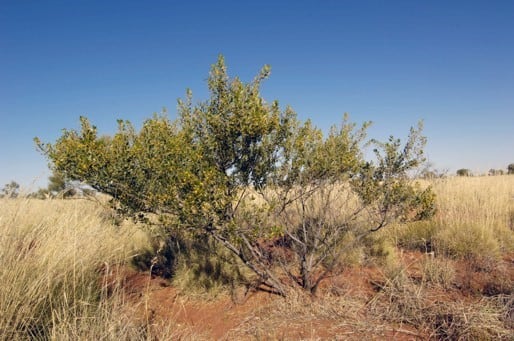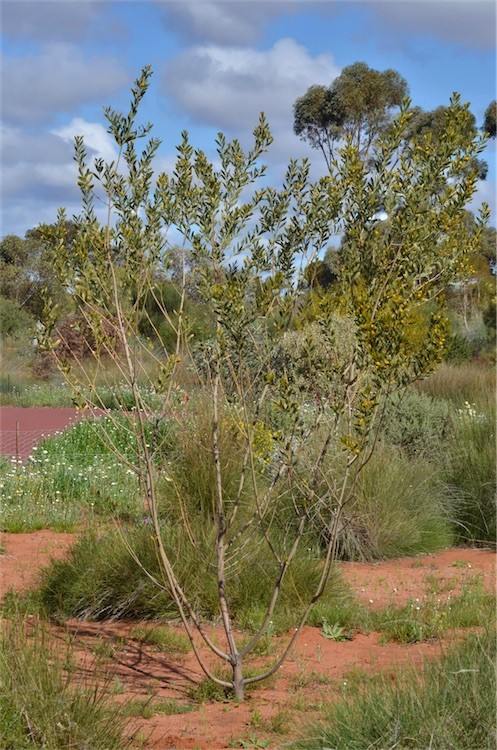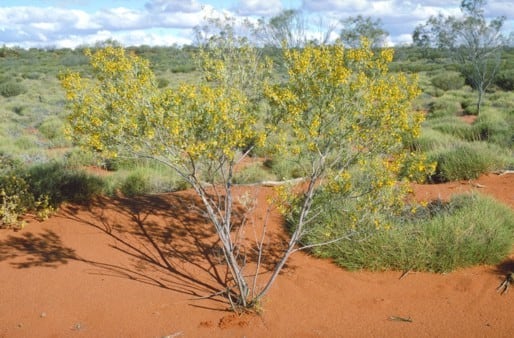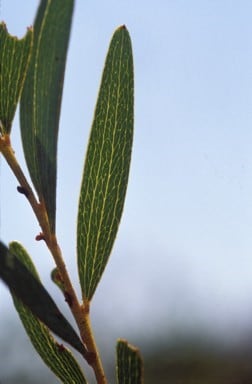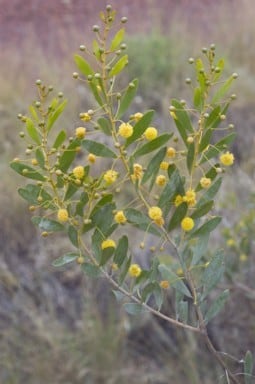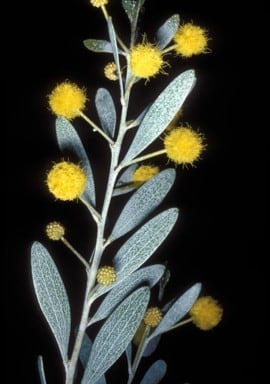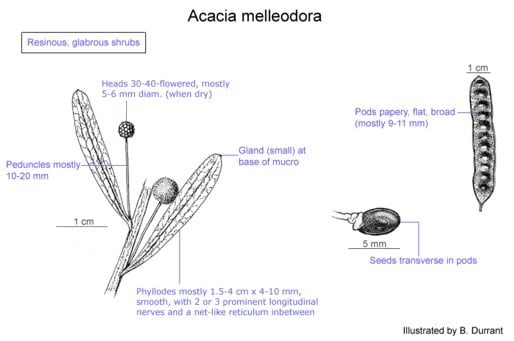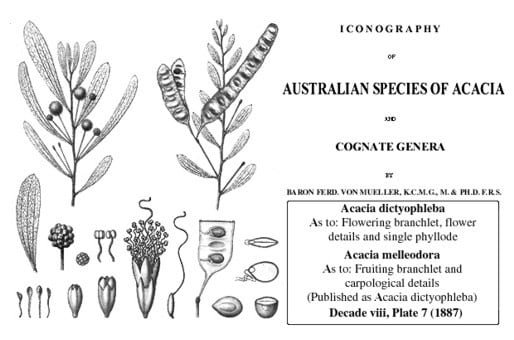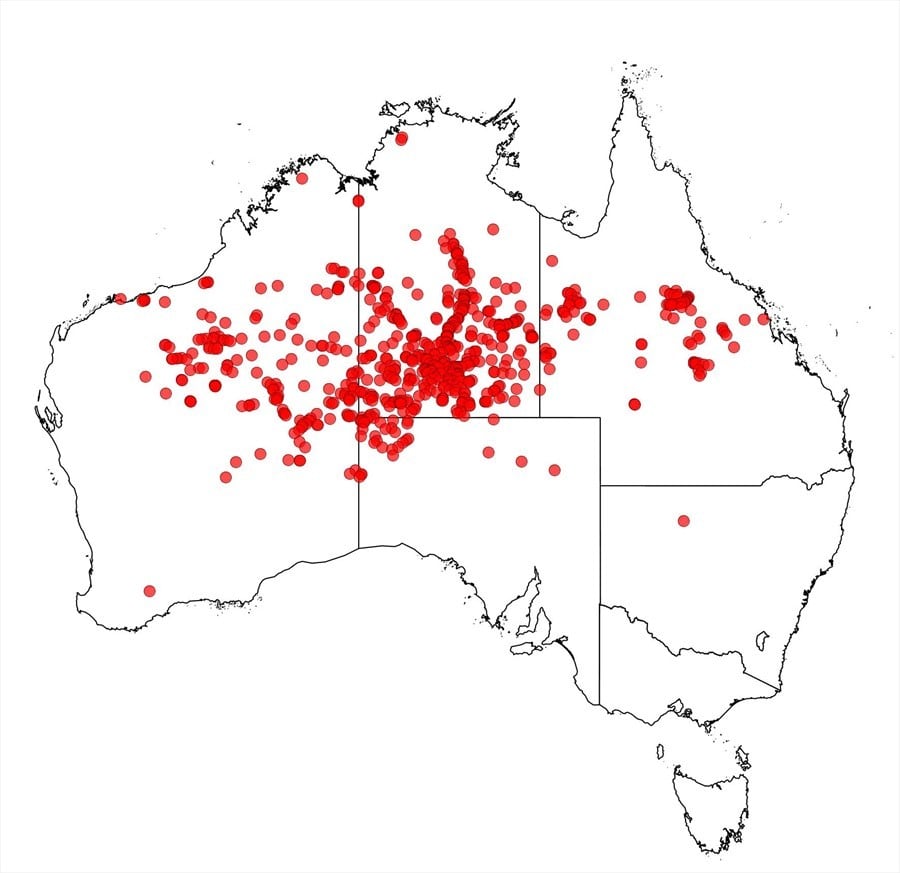Acacia melleodora Pedley
WATTLE
Acacias of Australia
Common Name
Scented Wax Wattle, Waxy Wattle
Family
Fabaceae
Distribution
Widespread and common in the N and central arid zone where it extends from the Pilbara region in W.A. eastwards through central and southern N.T. and north-western S.A. to central Qld.
Description
Shrub 1–4 m high, glabrous, resinous, viscid. Branchlets often sparsely tuberculate. Phyllodes obovate to oblanceolate or narrowly oblong-elliptic, 1.5–4 (–5) cm long, (3–) 4–10 (–15) mm wide, l:w = 3–6, obtuse, mucronulate, coriaceous to thinly coriaceous, smooth or sparsely tuberculate, dull grey-green or glaucous, frequently with a whitish bloom (especially over the nerves) due to dry resin; with 2 or 3 prominent longitudinal nerves, with secondary nerves forming a relatively fine, open, net-like reticulum; basal gland elongate, c. 1.5 mm long, with an obscure smaller gland at base of the minute apical mucro. Inflorescences simple, 1–3 per axil; peduncles 1–2 (–3) cm long, ebracteate at base; heads globular or obloid, 5–6 (–8) mm diam. when dry, densely 30–40-flowered, golden. Flowers 5‑merous; sepals united almost to their apices. Pods stipitate, oblong to narrowly oblong, flat, raised over seeds alternately on each side, to 9 cm long, 9–11 (–15) mm wide, firmly chartaceous, often ±vernicose; stipitate. Seeds transverse, c. 4 mm long, arillate.
Phenology
Flowers May–July.
Habitat
Grows in deep red or red-brown siliceous sand, on dunes or interdunal areas; sometimes found on shallow stony soils.
Specimens
W.A.: Upper Rudall R. area, B.R.Maslin 2093 (MEL, PERTH). N.T.: Heavitree Gap Ra. near Mt Gillen, M.Lazarides 5330 (BRI, DNA, PERTH). S.A.: c. 4.5 km ESE of Ampeinnia Hills, D.J.E.Whibley 6375 (AD, PERTH). Qld: 3 km E of Windorah towards Quilpie, M.E.Ballingall 2270 (BRI, PERTH).
Notes
Acacia melleodora, A. jensenii and A. sabulosa may ultimately prove to be better placed as infraspecific taxa of A. dictyophleba. Acacia jensenii and A. sabulosa are most readily distinguished from both A. dictyophleba and A. melleodora by their generally more elongate and predominantly 1-nerved phyllodes. Acacia melleodora is especially close to A. dictyophleba and in W.A. at least some intermediates appear to occur.
Can resprout from the base following fire although in most instances it is killed.
For Aboriginal use of A. melleodora in central Australia, refer to the discussion of A. dictyophleba in P.Latz, Bushfires & Bushtucker 96 (1995); it is probable that most of the information contained in this account refers to A. melleodora.
Phyllodes sometimes resemble those of which is distinguished by its generally hairy branchlets and pods, shorter peduncles with a persistent basal bract and longitudinal seeds. Acacia praemorsa and sometimes A. johnsonii also have an apical gland on the phyllode apex. . Narrow phyllode forms may superficially resemble A. orthotropica from Kimberley region, W.A., but the two species probably not especially closely related.
FOA Reference
Data derived from Flora of Australia Volumes 11A (2001), 11B (2001) and 12 (1998), products of ABRS, ©Commonwealth of Australia
Author
B.R.Maslin
This identification key and fact sheets are available as a mobile application:
URL: https://apps.lucidcentral.org/wattle/
© Copyright 2018. All rights reserved.
